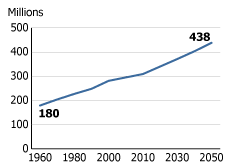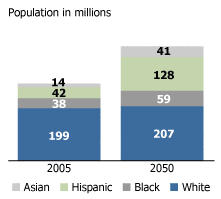Carl Haub
Demographer Emeritus

December 8, 2008
Demographer Emeritus
(February 2008) A new report from the Pew Research Center projects that immigration will propel the U.S. population total to 438 million by 2050, from 303 million today (see Figure 1). Along with this growth, the racial and ethnic profile of Americans will continue to shift—with non-Hispanic whites losing their majority status. (U.S. Population Projections: 2005-2050)
Figure 1
Actual and Projected U.S. Population Increase, 1960 to 2050

Source: Jeffery S. Passel and D’Vera Cohn, U.S. Population Projections: 2005-2050 (Washington, DC: Pew Research Center, 2008), accessed online at www.pewhispanic.org/files/reports/85.pdf, on Feb. 14, 2008.
It is no surprise that immigrants and their descendants will play a large role in future U.S. population growth, as they do now and have for much of the country’s history. But the projections detailed in the new report, authored by demographer Jeffrey S. Passel and writer D’Vera Cohn, differ from previous projections from the U.S. Census Bureau by assuming that the rate of immigration will hold steady—sending the net number of immigrants from 1.4 million per year in 2005 to 2.1 million per year by 2050 as the population total rises. This assumed increase in immigrants is, as the Pew report puts it, “in line with, but somewhat slower than, the growth trend of the last several decades.”
The Pew projections also offer a unique analysis of immigrants’ role by taking into account the different birth rates of first-, second-, and third-generation immigrants. The authors estimate that immigrants arriving after 2005, and their children and grandchildren, will account for 82 percent of the population growth between 2005 and 2050.
The report also provides considerable detail on the country’s future ethnic makeup (see Figure 2). With little immigration and low fertility, the non-Hispanic white population is projected to edge from 200 million to 207 million between 2005 and 2050, while the three other major racial and ethnic groups will see much more growth. The share of Non-Hispanic whites is slated to slip from 67 percent to 47 percent over the 45-year period. Indeed, they would decline in number by 2050, if not for immigration.
Figure 2
Increase in Size of Major U.S. Racial and Ethnic Groups, 2005 to 2050

Source: Jeffery S. Passel and D’Vera Cohn, U.S. Population Projections: 2005-2050 (Washington, DC: Pew Research Center, 2008), accessed online at www.pewhispanic.org/files/reports/85.pdf, on Feb. 14, 2008.
With the majority population holding steady, the significant growth must come from some other group—and it does. This is where the assumptions about immigration levels become crucial. Under Pew’s assumed immigration and fertility rates for major ethnic groups, the number of Hispanics will rise from 42 million to 128 million, and Asians from 14 million to 41 million.
Immigration is the most volatile demographic variable. Because it is affected by unforeseeable political, economic, and social forces, it is the most difficult to predict. Previous U.S. projections usually assumed either that immigration would taper off or would remain constant. But actual immigration levels have run above projected levels, and the resulting projections underestimated U.S. population growth. The 2000 Census count was about 7 million higher than expected, an indication that immigration was higher than assumed in the 1990s.
Given that U.S. population projections depend so heavily on the immigration assumption, and that immigration is certainly in the forefront of national attention, what are the pros and cons of an assumption that immigration will increase, albeit rather slowly?
Arguments for the immigration increase can begin with fundamental changes ushered in by the Immigration and Nationality Act amendments of 1965, which opened immigration to all regions of the world. Previous laws had favored the traditional sending countries in Europe. Immigration legislation since that time has only served to increase immigration further and no laws to seriously curb immigration are on the horizon. Indeed, some want to keep immigrants coming: viewing them as necessary to fill gaps in an aging U.S. labor force and to provide support for retirees.
The continued increase in immigration also suggests that the United States will continue to symbolize a better life for millions of people from developing countries, with a stronger economy and greater opportunities.
Global demographic trends also point to continued U.S. immigration. The populations of many sending countries and regions continue to grow, creating an expanding pool of potential immigrants. Africa will grow by about 1 billion between 2005 and 2050, India by at least a half billion. Latin America, the source of at least one-half of today’s immigrants, will add another 40 million or so.
Immigrants in the U.S. maintain ties to their home communities, and family reunification provisions in immigration law usually mean continued and sometimes increasing flow into the country. Unforeseen wars and political crises may bring new groups of immigrants as refugees, creating new links to countries abroad.
Why would immigration cease or slow? We could see some type of national consensus that population growth must be curbed in some way to preserve the quality of life and the environment. Economic conditions could improve in sending countries, dampening the enthusiasm for coming to the United States. It seems unlikely, but the U.S. economy could deteriorate to the point that it will no longer attract newcomers.
Regardless of what may happen in the future, the United States will become a more diverse country: The only question is how diverse. The assumptions underlying the new Pew report, as does any projection of the U.S. population, cause us to stop and think about the national demographic future.
Carl Haub is senior demographer at the Population Reference Bureau.
